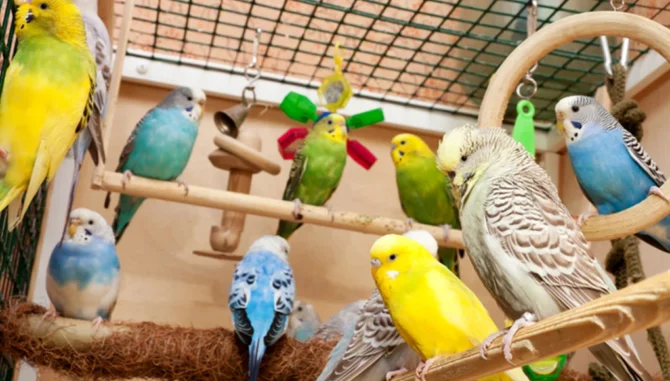Birds come in different shapes and sizes. Some are so small they fit perfectly into your palm, others so large they’d frighten you if they come up close.
The latter can either be flightless or have the ability to fly. This article focuses on the biggest flying birds, measured primarily by their wingspans and showcasing their impressive size and aerial abilities.
The largest flying birds in the world include the great white pelican, mute swan, California condor, Himalayan Griffon Vulture, and Eurasian Black Vulture, among others.
Without further ado, let us take a journey into the world of these soaring giant birds and discover their beauty and wonder.
The Largest Birds in the World
10. Andean Condor

- Wingspan: 9 ft 3 inches
- Length: 3 ft 3 to 4 ft 3 inches
- Weight: 33 pounds
- Identifying Features: Black plumage, redhead, and neck
- Where Found: South America
- Conservation Status: Vulnerable
- Scientific Name: Vultur gryphus
The Andean condor is considered the largest bird of prey in the world. With the combination of its weight and wingspan, it isn’t hard to see why.1
This bird is huge, which explains why it is a flying giant. It is a native of South America and is classified as vulnerable due to habitat loss and human persecution.
The Andean condor’s plumage is black, but there’s a group of white feathers at the neck base.
This makes it unlike other vultures that often have bald necks. The remaining parts of the neck are red, similar to the head.
Unlike many other birds of prey, the male Andean condor is slightly bigger than the female.
The Andean condor is also a scavenger, feeding on carrion.
Best Places to See the Andean Condor:
- Colca canyon of Peru
9. California Condor
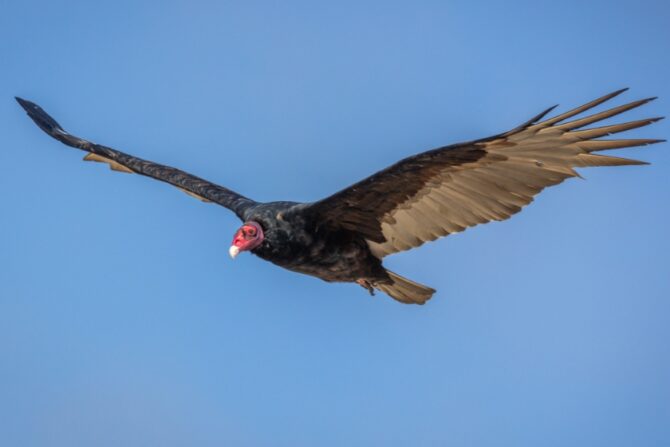
- Wingspan: 9 ft 8 in
- Length: 43 to 55 inches
- Weight: 26 pounds
- Identifying Features: Black plumage, bald head
- Where Found: North America
- Conservation Status: Critically Endangered
- Scientific Name: Gymnogyps californianus
The California Condor is considered the largest North American land bird and a huge vulture.
It can be found only in North America because it is critically endangered.
In 1987 it became extinct in the wild, but thankfully it got saved from total extinction with its reintroduction.
The California Condor can currently be found in places like Arizona, Utah, California, and Mexico.
The California Condor has black plumage but with some white patches on the underside.
The skin underneath the feathers is yellow and bright orange for the adult, while the juvenile is gray colored. Like every vulture, this bird’s head is bald, having little to no feathers.
The California Condor is a scavenger feeding on carrion.
Besides its size, it also holds the record of being one of the longest-living birds, with a lifespan of 60 years.
Best Places to See the California Condor:
- Pinnacles National Park, California
- Zion National Park, Utah
- Redwoods National Park, California
8. Cinereous Vulture
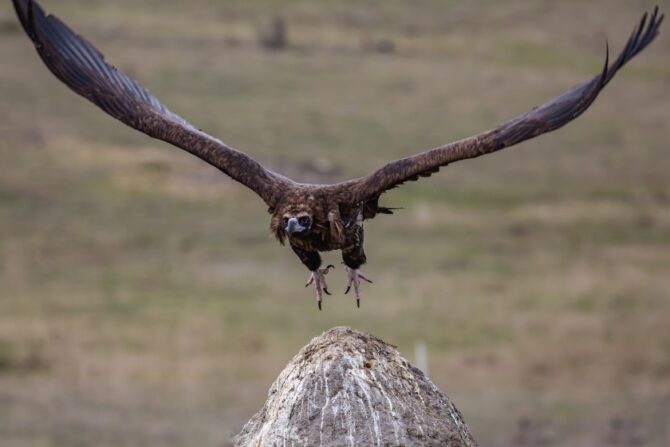
- Wingspan: 10 feet
- Length: 3 ft 11 inches
- Weight: 31 pounds
- Identifying Features: Dark brown, broad wings
- Where Found: Europe, Asia
- Conservation Status: Near Threatened
- Scientific Name: Aegypius Monachus
The cinereous vulture goes by many other names, like the Eurasian black vulture, monk vulture, or the black vulture.
It is a member of the Accipitridae family, the largest in it. The Eurasian black vulture is also one of the world’s heaviest-flying birds.
This bird comes in dark brown, despite the name stating black. The eyes are also brown, while the head and neck are bluish-gray.
Its bill and legs are also of the same color as the head and neck.
7. Himalayan Griffon Vulture
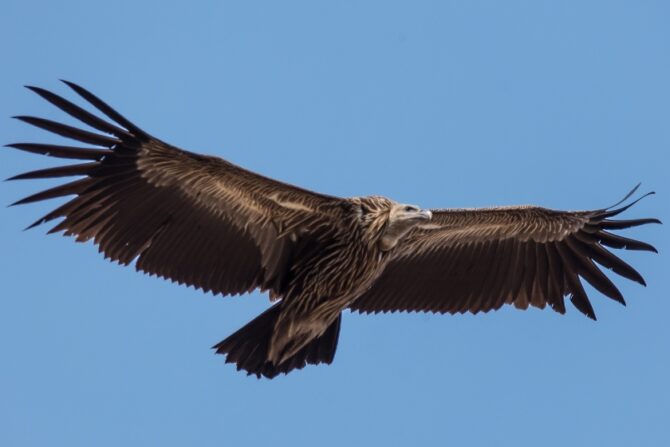
- Wingspan: 8 ft 5 in to 10 ft
- Length: 40.6 to 45.3 inches
- Weight: 13 to 28 pounds
- Identifying Features: Sandy brown, bald head
- Where Found: Kazakhstan, Afghanistan, Himalayas, Western China, Mongolia
- Conservation Status: Near Threatened
- Scientific Name: Gyps himalayensis
The Himalayan griffon vulture is one of the largest old-world vultures. It is often confused with the similar griffon vulture, but they are quite different. It is also similar to the Eurasian black vulture in size.
It has a robust, stout bill, a feathery leg, and an overall brown color.
Like every other vulture, it feeds on dead carrion, and due to its social nature, it often moves in flocks.
6. Marabou Stork

- Wingspan: 8 to 10 feet
- Length: 4.99 feet
- Weight: 20 pounds
- Identifying Features: Bare head and neck, white underparts
- Where Found: Sub-saharan Africa
- Conservation Status: Least Concern
- Scientific Name: Leptoptilos crumenifer
The Marabou stork has been given the moniker “Undertaker bird” because of its plumage, which looks much like a cloak.
Add the hunched posture with weird and scary looks, and you have the stereotypical undertaker seen in movies.
These birds were once considered the largest living bird, though that’s no longer the case today.
The overall color of this bird’s plumage is black, and the neck is as bald as that of a vulture.
Because of its size and these unique traits, the Marabou stork is easy to detect.
The baldness of the Marabou stork and vultures is good, though it may seem otherwise.
As scavengers, the Marabou gets into waste. The head and neck can only remain clean because of the lack of feathers. The Marabou stork feeds on carrion.
Best Places to See The Marabou Stork:
- Ben Lavin Nature Reserve, South Africa
- Kabiza Wilderness Safaris, Uganda
5. Tristan Albatross

- Wingspan: 11 feet
- Length: 43 inches
- Weight: 6.8 to 7.3 kg
- Identifying Features: Long wings, white plumage
- Where Found: South Atlantic, Brazil, Australia
- Conservation Status: Critically Endangered
- Scientific Name: Diomedea dabbenena
The Tristan Albatross is a part of the albatross family known as Diomedeidae.
It is one of the heaviest flying birds in the world, and because of its size, you can easily identify it.
Their range is not completely known, but it has been found foraging in the South Atlantic. It has been sighted around Brazil and Australia.
The Tristan Albatross is very similar to the wandering albatross also on this list. it is quieter than other swan species.
Its physical features include a white plumage, dark grey legs, and an orange beak.
It also has a knob on the bill. This animal used to be considered wild, but now you can find it in city parks and the waterways.
Males are larger than their female counterparts, with a more pronounced bill.
4. Northern Royal Albatross
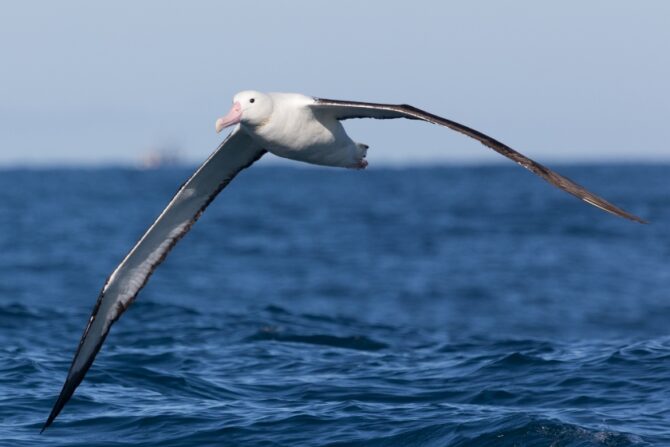
- Wingspan: 8.5 to 11 feet
- Length: 45 inches
- Weight: 14 to 18 pounds
- Identifying Features: Pink bill, dark wings
- Where Found: Chatham Islands, Auckland Islands, New Zealand
- Conservation Status: Endangered
- Scientific Name: Diomedea sanfordi
The Northern royal albatross is also called the toroa, and it belongs to the albatross family alongside its friend.
The Northern royal albatross and Southern royal albatross used to consider the same, but that changed in 1998 when they were split into different species.
However, the split is still controversial, as not all scientists agreed.
The Northern royal albatross is recognized mainly by its dark and long wings.
A lot of individuals have wings getting up to 10 feet. Another common trait of this bird is the pink bill, which is found in all ages. Older birds tend to be whiter than juveniles.
The Northern royal albatross is currently endangered, but it seems to have increased in population over the years.
Best Places to See The Northern Royal Albatross:
- South Island of New Zealand
3. Dalmatian Pelican

- Wingspan: 8 ft to 11 ft 6 inches
- Length: 5 ft 3 to 6 ft inches
- Weight: 16 to 33.1 pounds
- Identifying Features: Grey legs, silver plumage, grey wings
- Where Found: South Eastern Europe to Western Mongolia
- Conservation Status: Near Threatened
- Scientific Name: Pelecanus crispus
The Dalmatian Pelican is the largest member of the pelican family and one of the largest flying birds in existence today.
It is taller than the average human and also has a wingspan that’s long as well.
The Dalmatian Pelican is arguably the largest freshwater bird, though it has much competition from large swans.
The dalmatian pelican comes with a plumage that’s silvery white, with grey legs and an equally grey wing.
Like other pelicans, it isn’t very vocal, though it can be so in the mating season. The vocal sound is often described as harsh.
Despite its size, the dalmatian pelican is the very definition of elegant.
Best Places to See the Dalmatian Pelican:
- Greek lake of Kerkini, Greece
2. Great White Pelican

- Wingspan: 7 ft 5 to 11 ft 10 inches
- Length: 55 to 71 inches
- Weight: 20 to 33 pounds
- Identifying Features: White plumage,
- Where Found: Europe, Asia, Africa
- Conservation Status: Least Concern
- Scientific Name: Pelecanus onocrotalus
The great white pelican goes by many other names, like the rosy pelican, the white pelican, and the eastern white pelican.
It can be found in swamps and swallow lakes and has a wide range. It breeds across Europe, Asia, and Africa.
This bird is a large pelican, only surpassed by the Dalmatian pelican.
This bird is majorly white, but the flight feathers have a tinge of pink similar to the neck.
It also has short legs with webbed feet that help it swim above water. Completing its physical features is a pink and yellow bill.
The great white pelican is a social animal, often traveling in flocks. You’d recognize them flying by the V formation the group often take during flight.
Their colonies are large and do everything together, including breeding and feeding. These birds feed on fish, plucking it out of the waters.
Best Places to See the Great White Pelican:
- White Pelican Island, Florida
1. Wandering Albatross

- Wingspan: 8 ft 5 to 12 ft
- Length: 3 ft 6 to 4 ft 5 inches
- Weight: 13 to 28 pounds
- Identifying Features: Long wings, black and white plumage
- Where Found: South Georgia Islands, Crozet Islands, Hawaii, Atlantic Odyssey, New Zealand
- Conservation Status: Vulnerable
- Scientific Name: Diomedea exulans
Topping our list of large flying birds is the wandering albatross, also known as the goonie, the snowy albatross, or the white-winged.
It is a large seabird in the Diomedeidae family and has the longest wingspan among living birds.
The wings help it fly a great distance without flapping its wings.
Its plumage is a combination of white and black, with the bodies being white and the wings coming in black.
Juveniles usually have brown colors, which then whiten as they grow older.
There are a couple of differences between males and females, both in size and features.
The male is bigger than the female and also has whiter wings.
The wandering albatross has a long life span, getting up to 50 years.
They are also quite expressive with their words and gestures, using screams, whistles, grunts, and bill clapping.
Final Thoughts
The world is home to several magnificent species of large birds capable of taking flight and soaring high in the sky, and those that are flightless.
From the massive Andean condor to the elegant albatross, these biggest flying birds have amazed us with their impressive wingspans and aerial abilities.
These birds are fascinating to watch and play a crucial role in maintaining the delicate balance of nature.
As we continue to marvel at the beauty and grace of these creatures, it is important that we take steps to protect them and their habitats, ensuring that future generations will also be able to enjoy their magnificence.
So the next time you come across one of these soaring giants, take a moment to appreciate the wonder of these largest flying birds in the world.
Up Next…
- How Big Are Eagles? – Eagle size, wingspan, and weight.
- How Fast Can An Eagle Fly? – Discover the fastest-flying eagles.
References & Notes
- List of largest birds. (2023, February 2). In Wikipedia. https://en.wikipedia.org/wiki/List_of_largest_birds.




